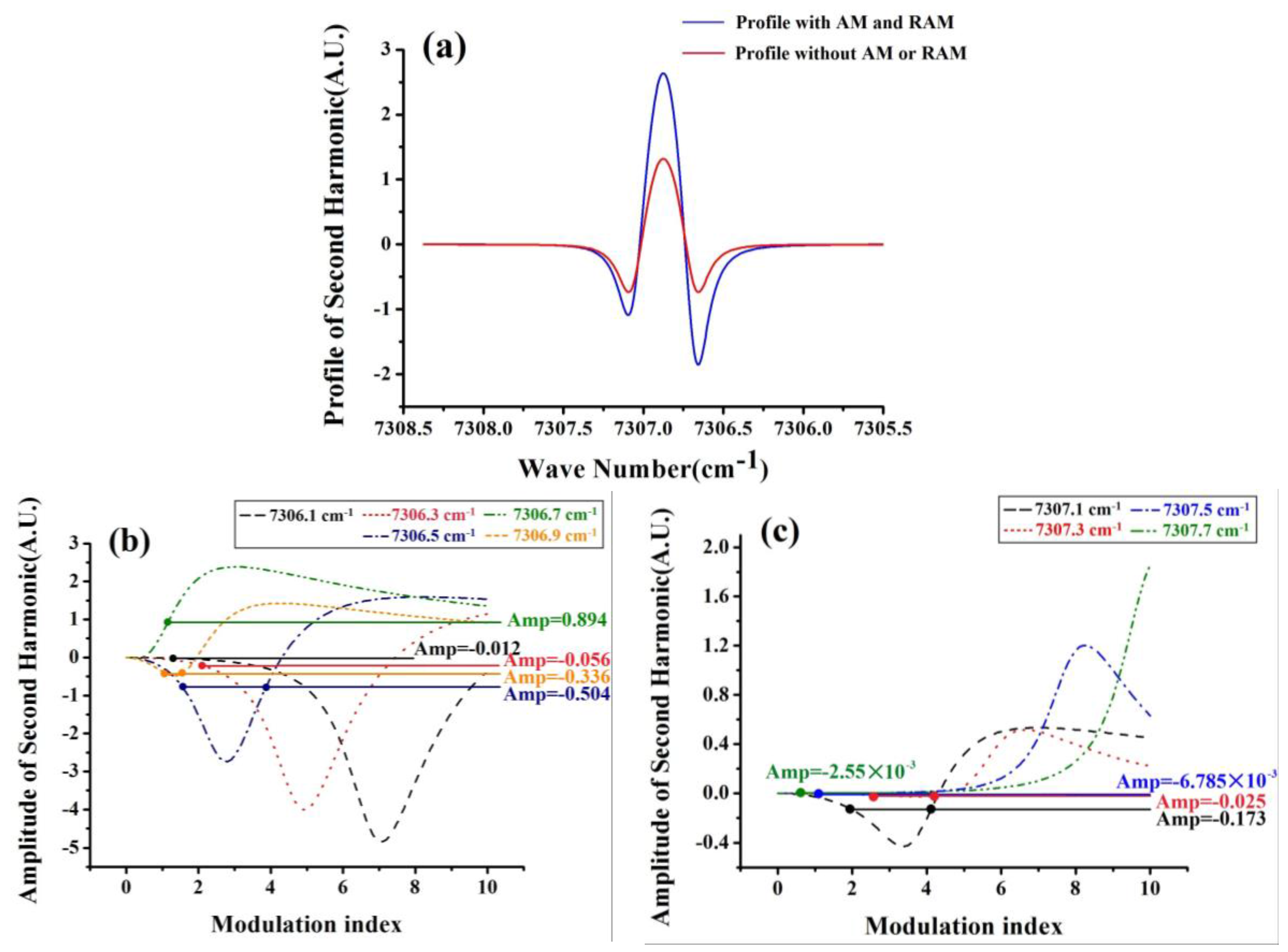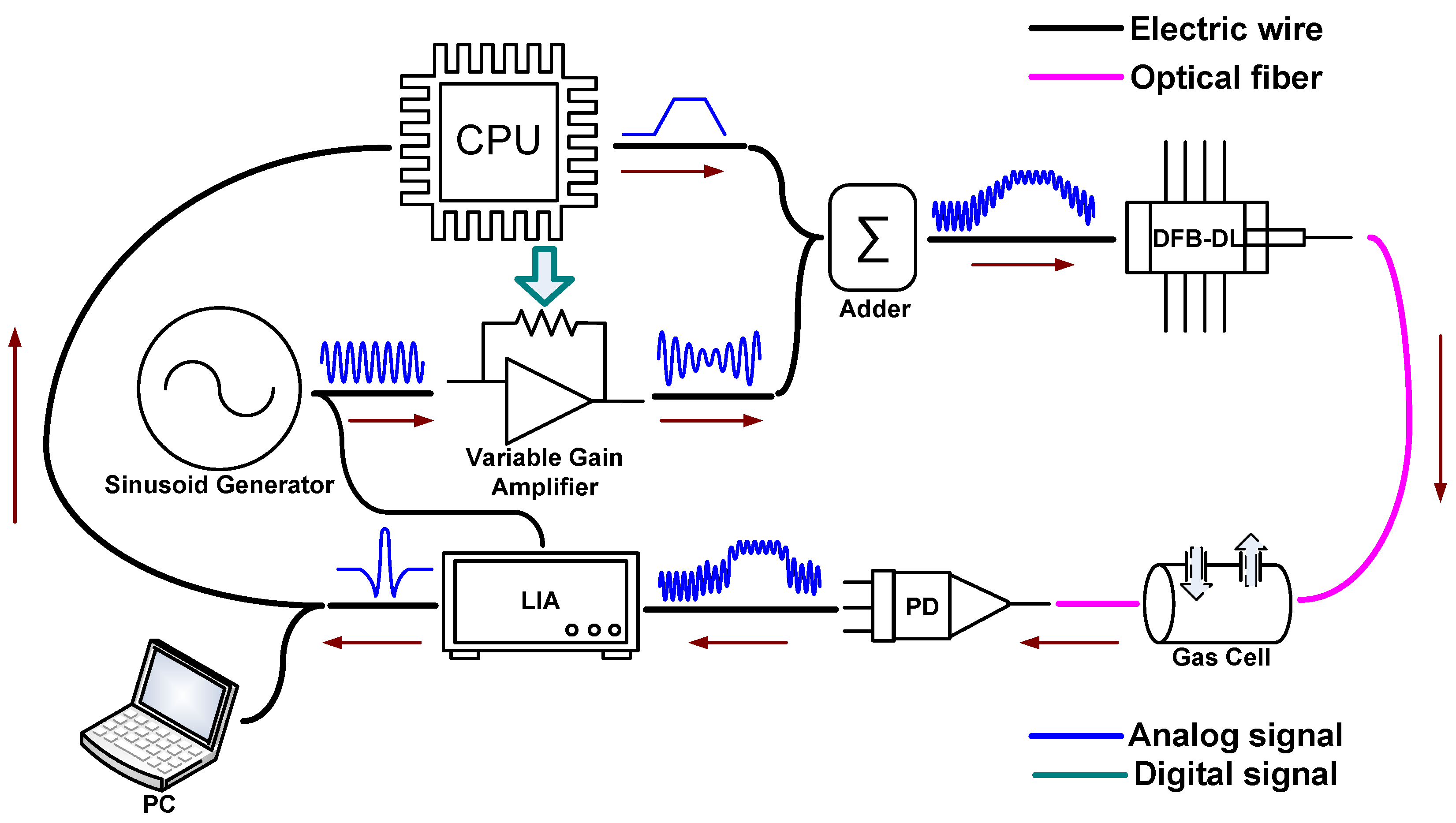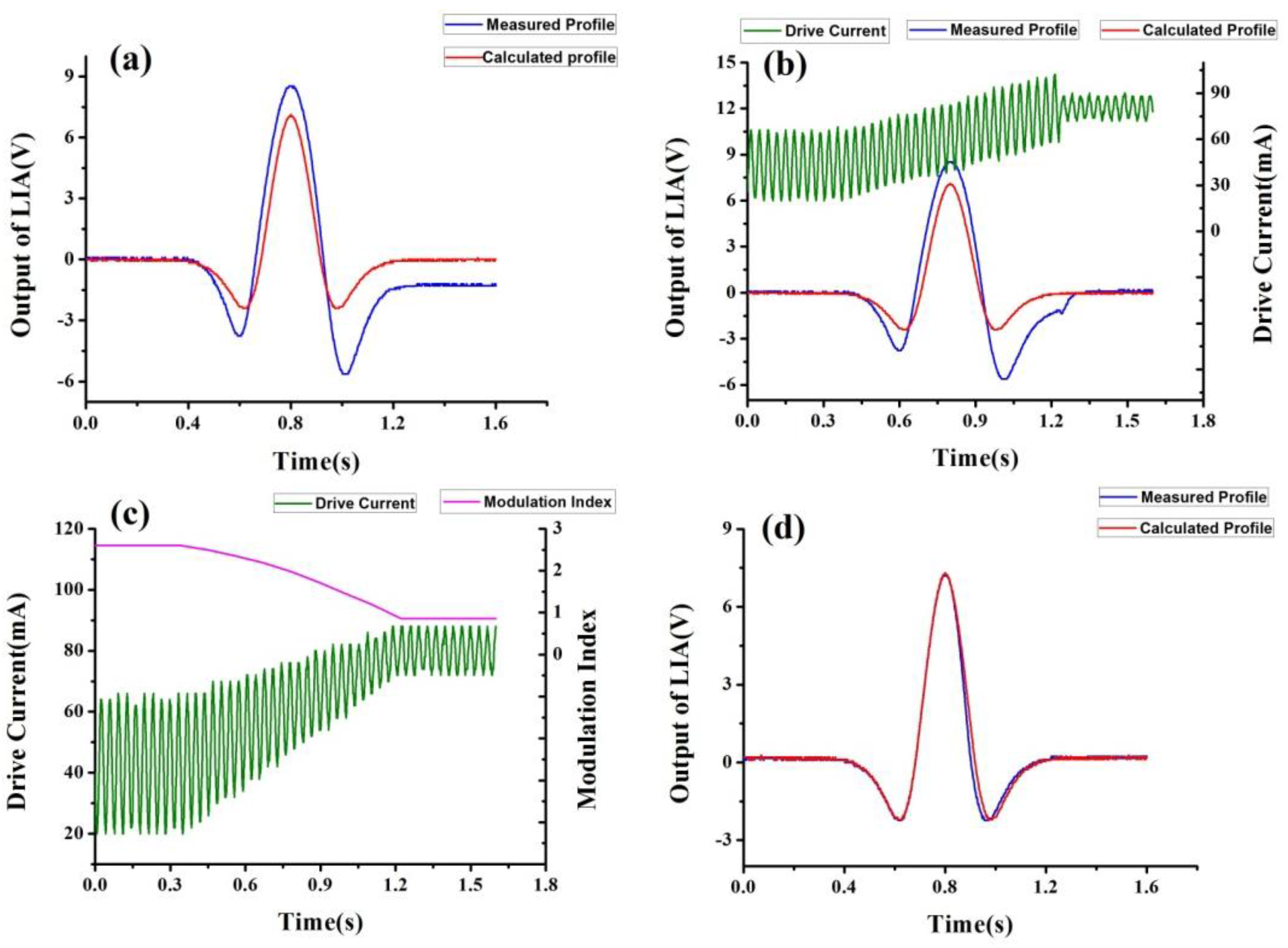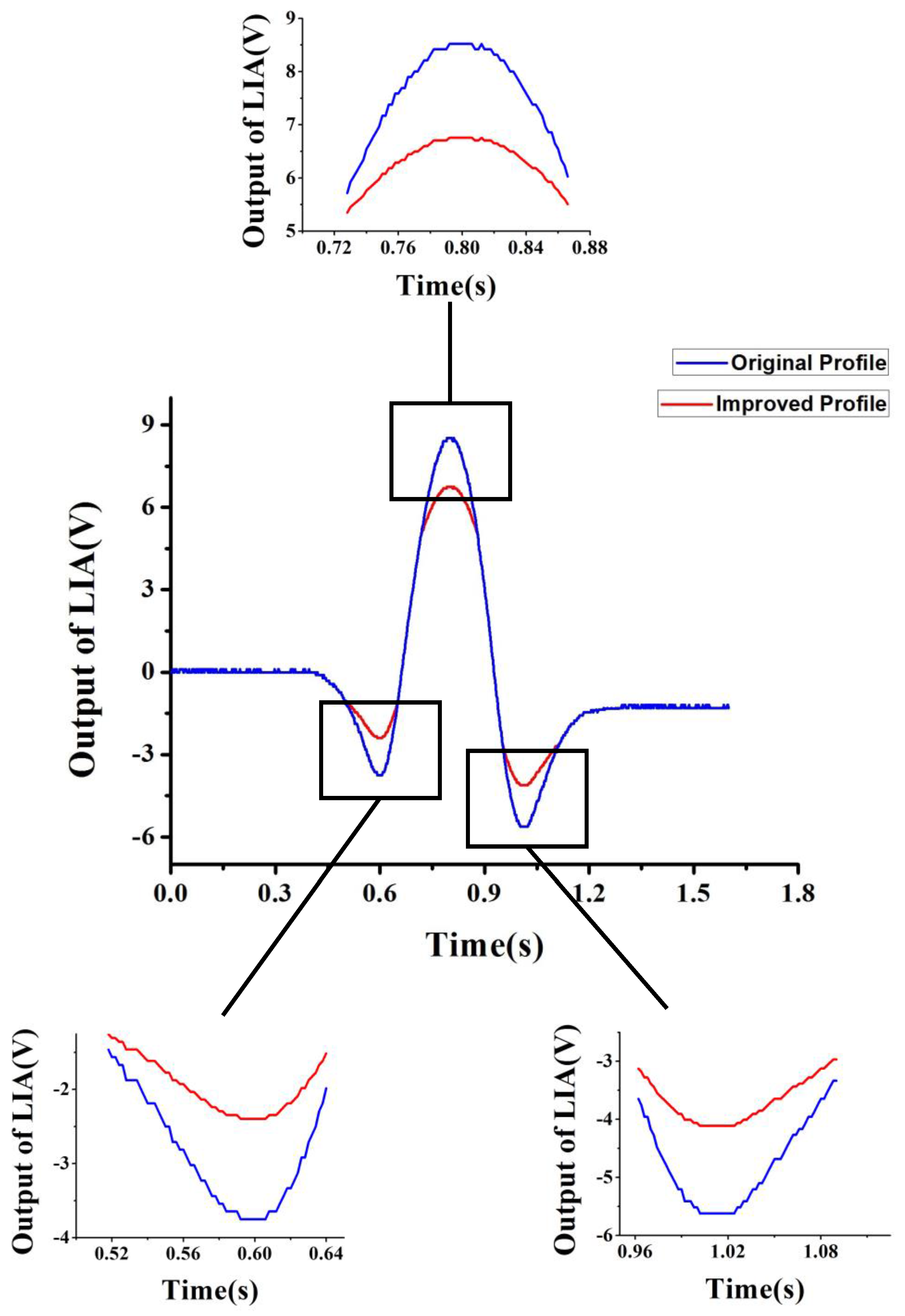Modulation Index Adjustment for Recovery of Pure Wavelength Modulation Spectroscopy Second Harmonic Signal Waveforms
Abstract
:1. Introduction
2. Analytical Treatment for Waveforms Recovery
3. Presentation of Experimental Setup
4. Measurement Results
5. Conclusions
Acknowledgments
Author Contributions
Conflicts of Interest
References
- Bolshov, M.A.; Kuritsyn, Y.A.; Liger, V.V.; Mironenko, V.R.; Leonov, S.B.; Yarantsev, D.A. Measurements of the temperature and water vapor concentration in a hot zone by tunable diode laser absorption spectrometry. Appl. Phys. B Lasers Opt. 2010, 100, 397–407. [Google Scholar] [CrossRef]
- Hunsmann, S.; Wunderle, K.; Wagner, S.; Rascher, U.; Schurr, U.; Ebert, V. Absolute, high resolution water transpiration rate measurements on single plant leaves via tunable diode laser absorption spectroscopy (TDLAS) at 1.37 μm. Appl. Phys. B Lasers Opt. 2008, 92, 393–401. [Google Scholar] [CrossRef]
- Durry, G.; Li, J.S.; Vinogradov, I.; Titov, A.; Joly, L.; Cousin, J.; Decarpenterie, T.; Amarouche, N.; Liu, B.; Parvitte, X.; et al. Near infrared diode laser spectroscopy of C2H2, H2O, CO2 and their isotopologues and the application to TDLAS, a tunable diode laser spectrometer for the martian PHOBOS-GRUNT space mission. Appl. Phys. B Lasers Opt. 2010, 99, 339–351. [Google Scholar] [CrossRef]
- Wang, Q.; Chang, J.; Zhu, C.-G.; Li, C.; Song, F.-J.; Liu, Y.-N.; Liu, X.-Z. Detection of water vapor concentration based on difference value of two adjacent absorption peaks. Laser Phys. Lett. 2012, 9, 421–425. [Google Scholar] [CrossRef]
- Wei, W.; Chang, J.; Sun, B.; Zhang, S.S.; Zhu, C.; Wang, Q.; Lv, G.; Liu, Z.; Wang, Z.; Zhou, S. Modified balanced ratio metric detection system used for high sensitive vapor detection. Optik 2015, 126, 2839–2843. [Google Scholar] [CrossRef]
- Ruxton, K.; Chakraborty, A.L.; Johnstone, W.; Lengden, M.; Stewart, G.; Duffin, K. Tunable diode laser spectroscopy with wavelength modulation: Elimination of residual amplitude modulation in a phasor decomposition approach. Sens. Actuators B Chem. 2010, 150, 367–375. [Google Scholar] [CrossRef]
- Bomse, D.S.; Stanton, A.C.; Silver, J.A. Frequency modulation and wavelength modulation spectroscopies: Comparison of experimental methods using a lead–salt diode laser. Appl. Opt. 1992, 31, 718–731. [Google Scholar] [CrossRef] [PubMed]
- Cassidy, D.T.; Reid, J. Atmospheric pressure monitoring of trace gases using tunable diode lasers. Appl. Opt. 1982, 21, 1185–1190. [Google Scholar] [CrossRef] [PubMed]
- Hinkley, E.D. High–resolution infrared spectroscopy with a tunable diode laser. Appl. Phys. Lett. 1970, 16, 351–354. [Google Scholar] [CrossRef]
- Loewenstein, M. Diode laser harmonic spectroscopy applied to in situ measurements of atmospheric trace molecules. J. Quant. Spectrosc. Radiat. Transf. 1988, 40, 249–256. [Google Scholar] [CrossRef]
- Reid, J.; Garside, B.K.; Shewchun, J.; El-Sherbiny, M.; Ballik, E.A. High sensitivity point monitoring of atmospheric gases employing tunable diode lasers. Appl. Opt. 1978, 17, 1806–1810. [Google Scholar] [CrossRef] [PubMed]
- Reid, J.; Shewchun, J.; Garside, B.K.; Ballik, E.A. High sensitivity pollution detection employing tunable diode lasers. Appl. Opt. 1978, 17, 300–307. [Google Scholar] [CrossRef] [PubMed]
- Lucchesini, A.; Longo, I.; Gabbanini, C.; Gozzini, S.; Moi, L. Diode laser spectroscopy of methane overtone transitions. Appl. Opt. 1993, 32, 5211–5216. [Google Scholar] [CrossRef] [PubMed]
- Lucchesini, A.; Rosa, M.D.; Pelliccia, D.; Ciucci, A.; Gabbanini, C.; Gozzini, S. Diode laser spectroscopy of overtone bands of acetylene. Appl. Phys. B Lasers Opt. 1996, 63, 277–282. [Google Scholar] [CrossRef]
- Pavone, F.S.; Inguscio, M. Frequency and wavelength–modulation spectroscopies: Comparison of experimental methods using an AlGaAs diode laser. Appl. Phys. B Lasers Opt. 1993, 56, 118–122. [Google Scholar] [CrossRef]
- Zhu, X.; Cassidy, D.T. Modulation spectroscopy with a semiconductor diode laser by injection–current modulation. J. Opt. Soc. Am. B 1997, 14, 1945–1950. [Google Scholar] [CrossRef]
- Wang, F.; Cen, K.F.; Li, N.; Huang, Q.X.; Chao, X.; Yan, J.H.; Chi, Y. Simultaneous measurement on gas concentration and particle mass concentration by tunable diode laser. Flow Meas. Instrum. 2010, 21, 382–387. [Google Scholar] [CrossRef]
- Wang, X.; Zhang, Y.J.; Xia, H.; Fang, X.; Kan, R.F.; Wang, T.D. Measurement of CO2 concentration in flame based on tunable diode laser absorption spectroscopy. J. Atmos. Environ. Opt. 2007, 2, 290–295. [Google Scholar]
- Duffin, K.; McGettrick, A.J.; Johnstone, W.; Stewart, G.; Moodie, D.G. Tunable diode-laser spectroscopy with wavelength modulation: A calibration-free approach to the recovery of absolute gas absorption line shapes. J. Lightwave Technol. 2007, 25, 3114–3125. [Google Scholar] [CrossRef]
- Wei, W.; Chang, J.; Huang, Q.; Zhu, C.; Wang, Q.; Wang, Z.; Lv, G. Wavelength modulation spectroscopy with signal–reference beam method for highly sensitive gas detection. Appl. Phys. B 2015, 118, 75–83. [Google Scholar] [CrossRef]
- Rieker, G.B.; Jeffries, J.B.; Hanson, R.K. Calibration-free wavelength-modulation spectroscopy for measurements of gas temperature and concentration in harsh environments. Appl. Opt. 2009, 48, 5546–5560. [Google Scholar] [CrossRef] [PubMed]
- Goldenstein, C.S.; Spearrin, R.M.; Hanson, R.K. Fiber-coupled diode-laser sensors for calibration-free stand-off measurements of gas temperature, pressure, and composition. Appl. Opt. 2016, 55, 479–484. [Google Scholar] [CrossRef] [PubMed]
- Schilt, S.; Thévenaz, L.; Robert, P. Wavelength modulation spectroscopy: Combined frequency and intensity laser modulation. Appl. Opt. 2003, 42, 6728–6738. [Google Scholar] [CrossRef] [PubMed]
- Philippe, L.C.; Hanson, R.K. Laser diode wavelength–modulation spectroscopy for simultaneous measurement of temperature, pressure and velocity in shock-heated oxygen flows. Appl. Opt. 1993, 32, 6090–6103. [Google Scholar] [CrossRef] [PubMed]
- Patimisco, P.; Sampaolo, A.; Bidaux, Y.; Bismuto, A.; Scott, M.; Jiang, J.; Muller, A.; Faist, J.; Tittel, F.K.; Spagnolo, V. Purely wavelength- and amplitude-modulated quartz-enhanced photoacoustic spectroscopy. Opt. Express 2016, 24, 25943–25954. [Google Scholar] [CrossRef] [PubMed]
- Chakraborty, A.L.; Ruxton, K.; Johnstone, W.; Lengden, M.; Duffin, K. Elimination of residual amplitude modulation in tunable diode laser wavelength modulation spectroscopy using an optical fiber delay line. Opt. Express 2009, 17, 9602–9607. [Google Scholar] [CrossRef] [PubMed]
- Chakraborty, A.L.; Ruxton, K.; Johnstone, W. Influence of the wavelength-dependence of fiber couplers on the background signal in wavelength modulation spectroscopy with RAM-nulling. Opt. Express 2010, 18, 267–280. [Google Scholar] [CrossRef] [PubMed]
- Chang, H.; Chang, J.; Huang, Q.; Wang, Q.; Tian, C.; Wei, W.; Liu, Y. Immunity to Laser Power Variation in a DFB Diode Laser Based Optical Gas Sensor Using a Division Process. Sensors 2015, 15, 9582–9591. [Google Scholar] [CrossRef] [PubMed]
- Wang, Q.; Chang, J.; Wei, W.; Zhu, C.; Tian, C. Dual-beam wavelength modulation spectroscopy for sensitive detection of water vapor. Appl. Phys. B 2014, 117, 1015–1023. [Google Scholar] [CrossRef]
- Stewart, G.; Johnstone, W.; James Bain, R.P.; Ruxton, K.; Duffin, K. Recovery of Absolute Gas Absorption Line Shapes Using Tunable Diode Laser Spectroscopy with Wavelength Modulation—Part I: Theoretical Analysis. J. Lightwave Technol. 2011, 29, 811–821. [Google Scholar]
- Zhu, C.; Chang, J.; Wang, P.; Wei, W.; Wang, Q.; Wang, F.; Zhang, S. Continuously wavelength-tunable light source with constant-power output for elimination of residual amplitude modulation. IEEE Sens. J. 2015, 15, 316–321. [Google Scholar] [CrossRef]




© 2017 by the authors; licensee MDPI, Basel, Switzerland. This article is an open access article distributed under the terms and conditions of the Creative Commons Attribution (CC-BY) license (http://creativecommons.org/licenses/by/4.0/).
Share and Cite
Wei, W.; Chang, J.; Wang, Q.; Qin, Z. Modulation Index Adjustment for Recovery of Pure Wavelength Modulation Spectroscopy Second Harmonic Signal Waveforms. Sensors 2017, 17, 163. https://doi.org/10.3390/s17010163
Wei W, Chang J, Wang Q, Qin Z. Modulation Index Adjustment for Recovery of Pure Wavelength Modulation Spectroscopy Second Harmonic Signal Waveforms. Sensors. 2017; 17(1):163. https://doi.org/10.3390/s17010163
Chicago/Turabian StyleWei, Wei, Jun Chang, Qiang Wang, and Zengguang Qin. 2017. "Modulation Index Adjustment for Recovery of Pure Wavelength Modulation Spectroscopy Second Harmonic Signal Waveforms" Sensors 17, no. 1: 163. https://doi.org/10.3390/s17010163
APA StyleWei, W., Chang, J., Wang, Q., & Qin, Z. (2017). Modulation Index Adjustment for Recovery of Pure Wavelength Modulation Spectroscopy Second Harmonic Signal Waveforms. Sensors, 17(1), 163. https://doi.org/10.3390/s17010163





